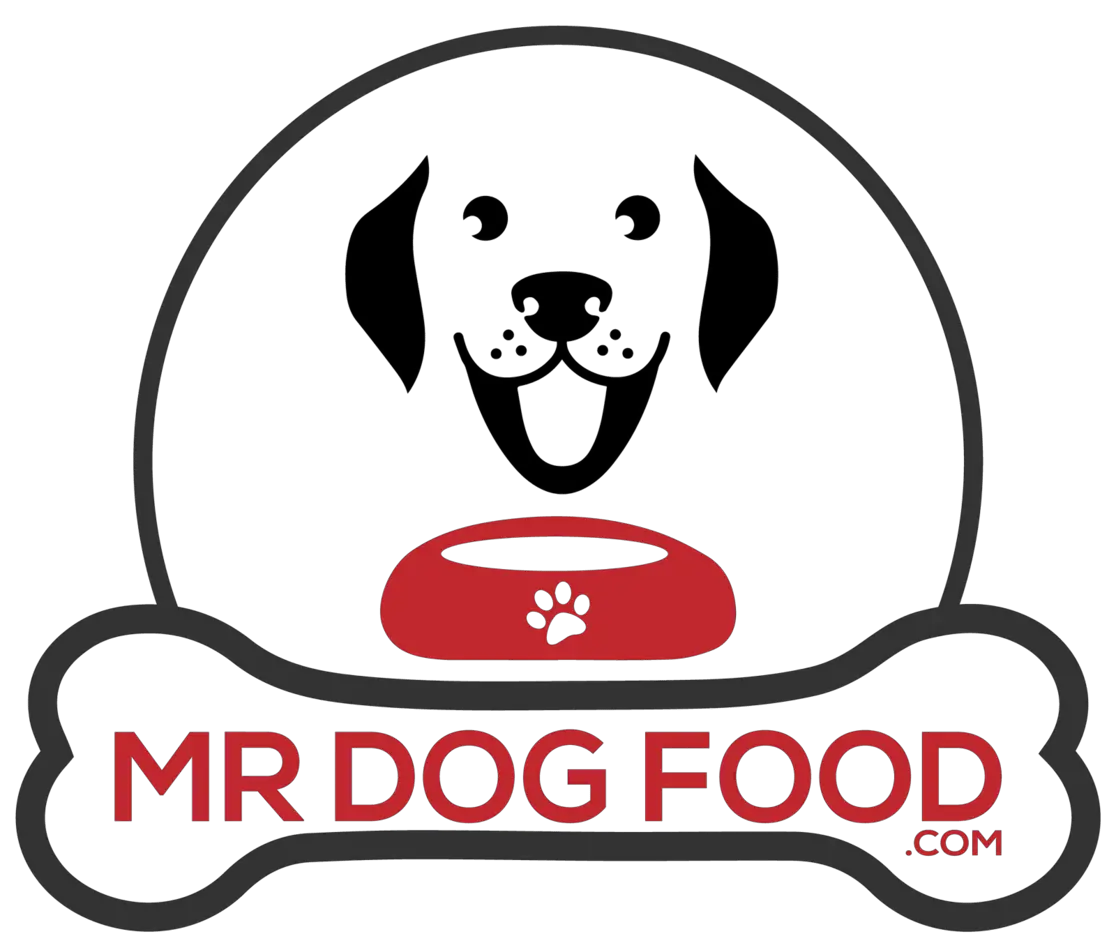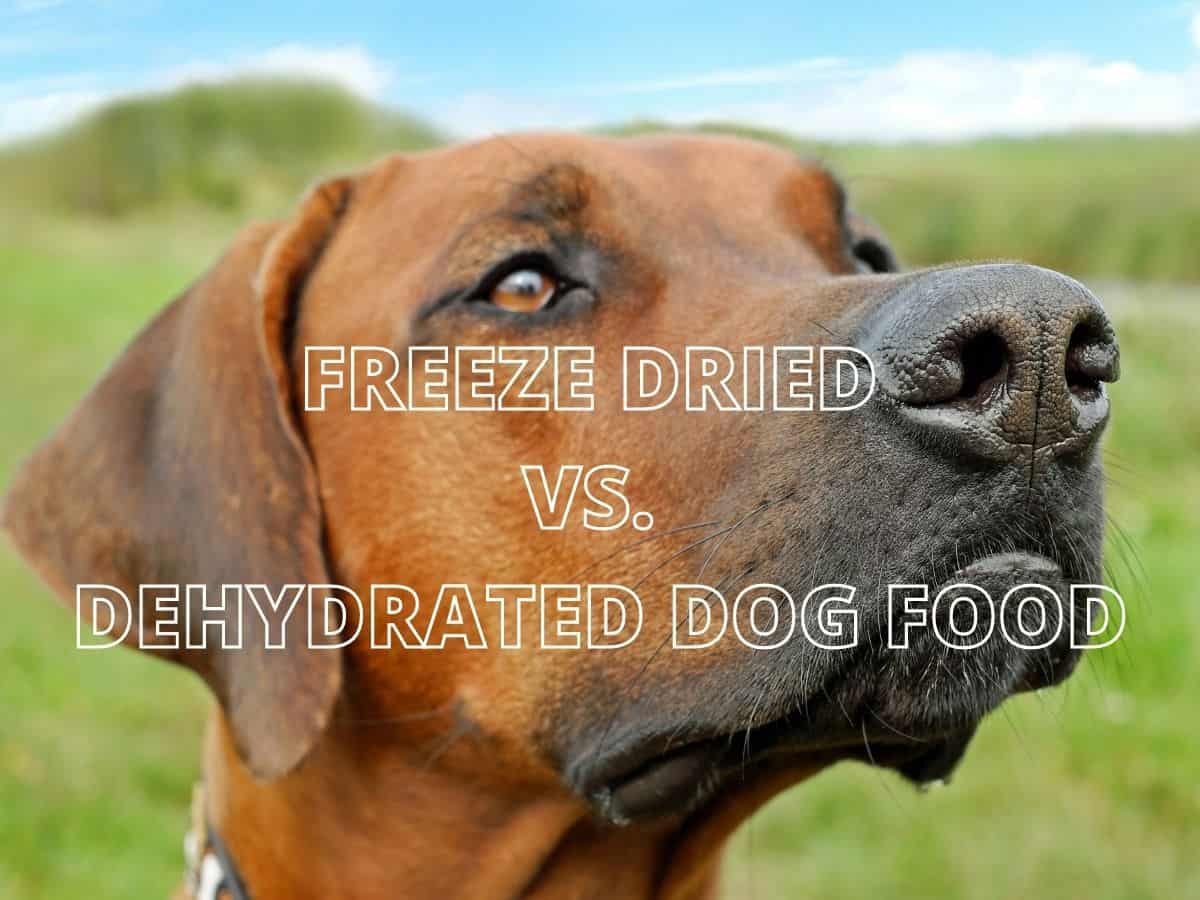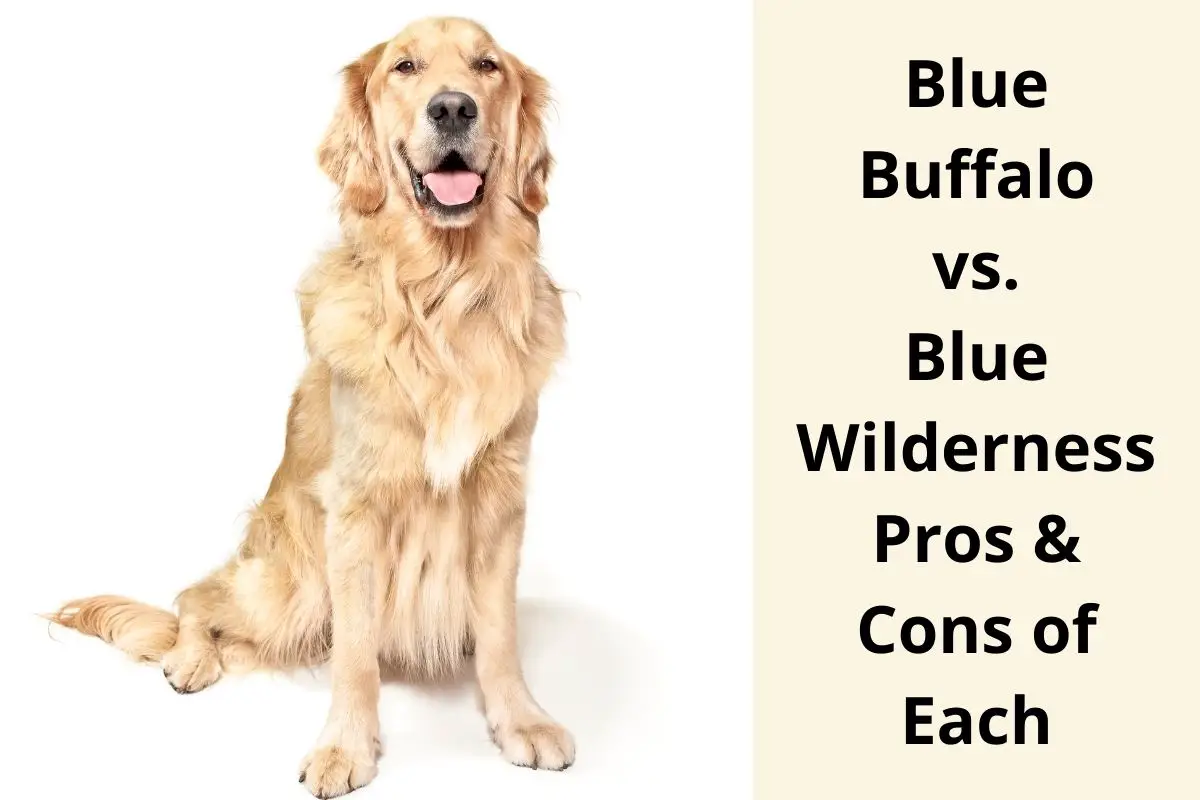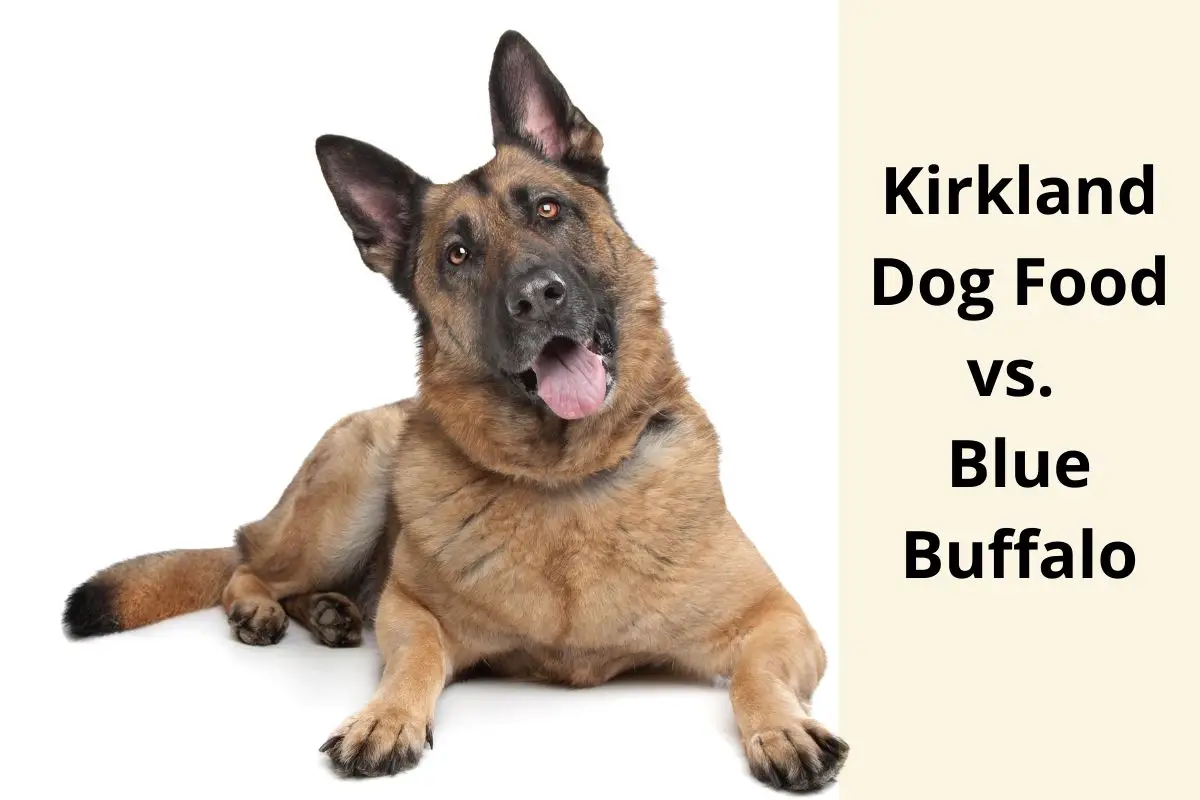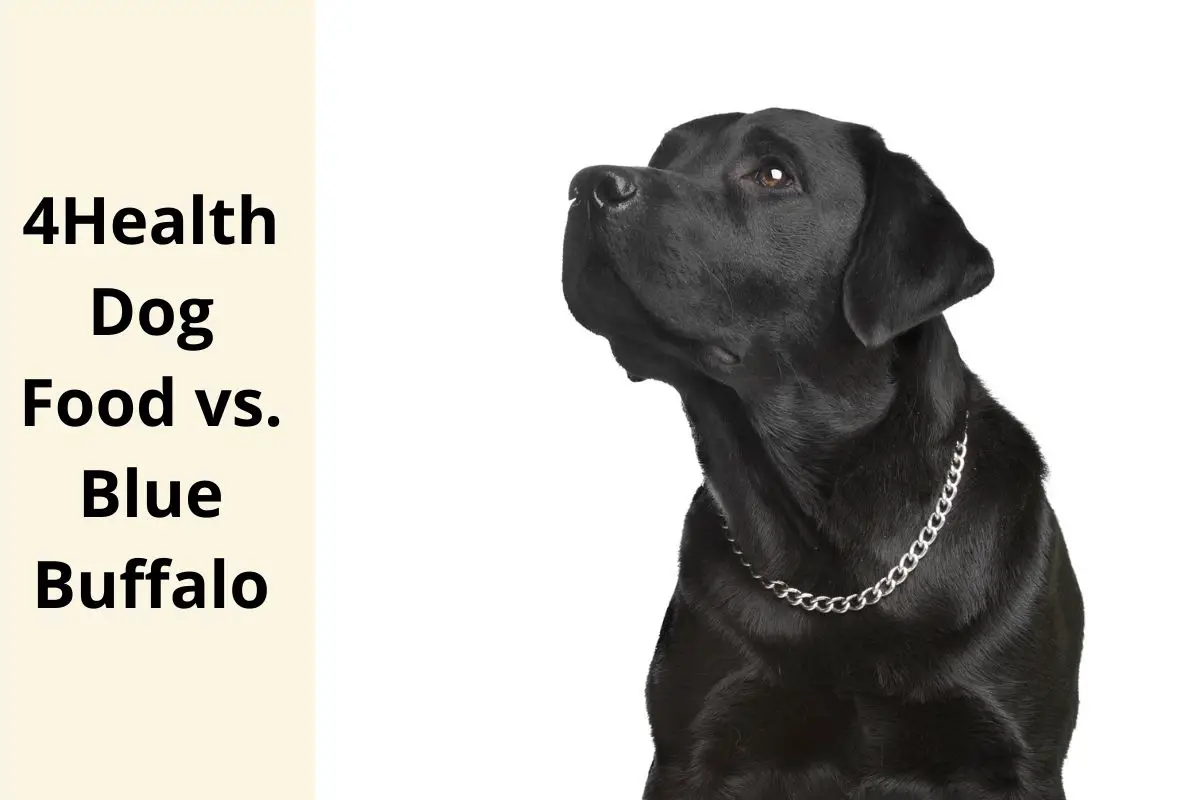This post contains affiliate links.
Visit any pet food store, and you’ll notice that there’s a wide variety of dog foods available. Apart from kibbles, two of the most prominent categories are freeze-dried and dehydrated, and these two food types are often mistaken to mean the same thing. However, they are different, and each has its advantages and disadvantages.
The key difference between the two dog food types is that freeze-dried foods are first frozen before moisture is extracted out of them, while dehydrated foods undergo heating to remove moisture. As a result, freeze-dried foods retain most of their nutrients, while dehydrated foods lose almost 50%.
Here, we will take a detailed look at each dog food type, including how they are prepared and the key differences between them. We’ll also comprehensively cover their pros and cons, what kind of dog can consume them, and how to transition your dog to this category of foods.
Table of Contents
Understanding Dried Foods and Food Preservation
Unless food is preserved in some way, it will go bad very quickly and accumulate disease-causing bacteria. In any food preservation techniques, the goal is to remove moisture from the food. The removal of moisture helps to inhibit the growth of microorganisms such as mold, yeasts, and bacteria.
In the production of kibble and canned dog foods, the food is cooked at high pressure and temperature in a special machine. Dehydration and freeze-drying are a bit different.
Dehydration used to be the main preservation method and has been in use for thousands of years. In the past, the most common methods of dehydration were sun drying, smoke or fire drying, and burying food in hot sand. Today, there are modern tools that help to improve and simplify the process.
Freeze-drying has also been in existence for quite some time but is still relatively new compared to dehydration. Freeze-drying was used during World War II by the USA and Europe to distribute shelf-stable blood serum to care for wounded troops. Today, freeze-drying mostly requires modern and high-tech tools and machinery.
What Is Freeze-Dried Dog Food?
Freeze-drying of dog food is usually done by placing food in a vacuum chamber that reduces the temperature of the food. The food is kept in the chambers until its temperature is below freezing, after which it is slowly raised to remove the moisture.
During freeze-drying, the temperature and pressure are closely monitored to ensure that the moisture changes state from solid to gaseous, without ever going through or changing back to a liquid state, a process called sublimation. This process nearly removes all the moisture, but it doesn’t affect the food and its ingredients.
Because the food is also subjected to high pressure, some of the harmful bacteria in the food may be destroyed. However, it’s an expensive process and requires large, advanced machinery.
The ingredients in freeze-dried foods are mostly meats, but fruits and vegetables are sometimes added. These ingredients are still raw and only undergo minimal processing.
You can feed your dog freeze-dried food without rehydrating it, but it’s recommended to make it more palatable and tastier for your dog.
What Is Dehydrated Dog Food?
Dehydration of dog food is done by circulating hot and dry air across the food to dry out the moisture. It is usually done at a low temperature so that it doesn’t completely cook the food or break down all the naturally-occurring proteins and nutrients in the food. The food is also not considered completely raw; however, its taste, texture, and nutrients may be altered.
When modern equipment is used, the operator has control over the air temperature, which usually ranges from 95 ℉ (35 ℃) to 165 ℉ (74 ℃). Dehydration is not as complex as freeze-drying and does not require sophisticated equipment.
Main Differences Between Freeze-Drying and Dehydration
Although these two terms are often used by some people to refer to the same type of food, it is clear that freeze-drying and dehydration are two different food preservation methods.
Freeze-dried foods don’t undergo heat at any point during the manufacturing process; they retain the texture, smell, and taste of their original form. In contrast, there is always a noticeable difference from its original form after food has been dehydrated.
Also, during freeze-drying, about 98 to 99 percent of the moisture content is removed, but only about 90 to 95 percent moisture is removed during dehydration. This gives freeze-dried dog food a much longer average shelf-life than dehydrated dog food. Also, because dehydrated dog food contains more moisture, it is denser and heavier in weight than freeze-dried food.
Probably the biggest difference between the two dog food types is the nutritional content. In a research by the American Institute for Cancer Research (AICR), it was found that freeze-dried foods retain most of their original vitamins and minerals. This minuscule nutrient loss means that you don’t need to add any vitamins or minerals to provide your dog with a balanced diet.
In contrast, dehydrated dog foods lose about 50% of their original nutrients. This high nutrient loss is because the process is more invasive, and the food is subjected to a lot of heat. If you’re feeding your dog dehydrated food, you’ll need to add minerals or supplements to provide him with a complete and balanced diet.
The final noticeable difference is that freeze-dried dog foods are crispy and edible, and your pup can easily digest them. Dehydrated foods may be difficult for your pulp to chew as they have a hard, cooked texture.
How Do You Store Freeze-Dried and Dehydrated Dog Food?
It’s best to store freeze-dried or dehydrated dog food in their original packaging or container. You also need to tightly reseal the package after opening it. Store it in a cool, dry place and ensure you keep it out of sunlight and damp areas.
Some experts also suggest opening the bag of food and placing it in a dog food storage container. This will help in preserving the freshness of the food and protect it from rodents and insects.
It is not recommended to refrigerate dehydrated food as it can absorb moisture. Since the goal is to remove moisture in the first place, adding moisture can change its state and make it go rancid quickly. However, if you wish to freeze it, we suggest rehydrating it first and dividing it into individual portions before placing it in the freezer.
Freeze-dried dog foods are best stored in mylar bags. Mylar bags are made from metalized polyester, which blocks sunlight and locks out heat and moisture. They are great for storing food long term. You can also store freeze-dried foods in airtight, nitrogen-packed cans.
If you can’t use mylar bags or nitrogen packed cans, keep your freeze-dried dog food in its original container or transfer it to an airtight container. It will stay fresher when you protect it from moisture. Just like dehydrated dog food, you can rehydrate freeze-dried food and place individual portions in the freezer.
How Long Does Dehydrated Dog Food Last?
Depending on the brand and product line, dehydrated dog food can last for up to 1 to 2 years. You may need to verify with the brand to find out exactly how long it can last and still be safe for your dog to eat.
Once rehydrated, any leftovers must be stored in the fridge. In the fridge, it can stay good for up to 2–3 days. If you plan to store it for longer, place it in the freezer. However, keeping it in the freezer for too long can cause it to lose its color, texture, and quality.
Before serving your dog frozen leftovers, we suggest adding and stirring in some warm water to improve its taste and appearance for your dog.
How Long Does Freeze-Dried Dog Food Last?
The freeze-drying process is not all that perfect, and there’s still some moisture left in the food, so you can expect that it will eventually go bad. As mentioned earlier, freeze-dried dog food has a longer shelf life than dehydrated dog food. Typically, freeze-dried dog food can last up to 2 to 2.5 years, depending on the brand.
While freeze-dried dog foods can last for a long time, keeping it for too long before using it can cause it to lose some of its nutritional value, especially if it’s exposed to air or heat. After rehydrating freeze-dried food, treat it like canned dog food and use it immediately. Any leftovers should be refrigerated or frozen if you plan to keep it for longer.
With both dog food types, we recommend feeding it to your dog within six months of buying it and within 30 days of opening it. To extend its shelf life, reseal it in its original bag or transfer it to an airtight container and store in a cool, dry place or the refrigerator. The original bags are temperature and moisture resistant, so we recommend using them.
Can Freeze-Dried or Dehydrated Dog Food Still Be Considered Raw?
Both types of dog food are processed in some way, but that doesn’t mean it has been cooked. Dehydrated dog food undergoes some heat during manufacturing, so it can be considered partially raw since it is only very lightly cooked.
Freeze-dried dog foods are not exposed to heat during manufacturing, so they can still be considered raw. When rehydrated, freeze-dried dog food returns to its original form, with no change in appearance or texture.
Pros and Cons of Freeze-Dried and Dehydrated Dog Food
Both freeze-dried and dehydrated dog food has its advantages and disadvantages. Here are some of them to help you decide on what suits your dog.
Pros of Freeze-Dried Dog Food
- It only takes about 2 to 3 minutes to rehydrate freeze-dried dog food. Sometimes, it doesn’t need rehydration.
- Freeze-dried dog food has a longer shelf-life because of the low moisture content.
- Most of the original nutrients in the ingredients are retained.
- A little amount of water needed to rehydrate it, making it convenient for storing and traveling.
- Easy for both young and old dogs to chew and digest. It also tastes better.
Cons of Freeze-Dried Dog Food
- It is still raw, and the freeze-drying process does not remove any bacteria that may be present in the food.
- It contains less fiber.
- It is more expensive than your regular kibble. This is as a result of the modern equipment needed to carry out the process.
- Some freeze-dried dog foods can contain a lot of fat.
Pros of Dehydrated Dog Food
- It goes through heat, which can help to eliminate bacteria in the food.
- No need to refrigerate dehydrated food to preserve it.
- Dehydrated dog foods are less expensive than freeze-dried foods.
Cons of Dehydrated Dog Food
- Rehydrating dehydrated pet food takes about 5 to 10 minutes. Depending on the size of the food chunks, it may need to be soaked for some hours.
- About 50% of the nutrients in the ingredients are lost during drying and heating.
- More water is needed to rehydrate and use, which makes it less convenient to take on the road.
- Decent shelf life for dehydrated foods, but it is lower than that of freeze-dried foods.
- It can be difficult for pups with sensitive teeth to chew.
Freeze Dried or Dehydrated Food: Which Is Better for Your Dog?
Each dog food type has its strengths and weaknesses. However, the most important thing to consider is your dog’s needs and how his body will metabolize the vitamins and minerals in the food. You want to feed your dog the type of food that is easy to digest and process, so his body can use the nutrients and not just convert it to poop.
For Puppies
It is important to start your puppy off on the right diet. When choosing dehydrated or freeze-dried food for your dog, you need to pay attention to the brand and product formulation. Some products are designed specifically for puppies, while others can be eaten by all dogs, regardless of their age.
Dehydrated dog food may be hard for your pup to chew. Freeze-dried foods are better in this regard as they retain more of the original taste of the food and are easier to chew. They also retain most of their nutrients, so your dog will be provided with all the vitamins and minerals he needs. With dehydrated food, you may need to add supplements or vitamins to your dog’s diet.
However, your pup may not like the raw taste of freeze-dried food and may prefer the partially cooked dehydrated dog food. You may have to try several brands to find out what your dog prefers.
For Senior Dogs
Both freeze-dried and dehydrated dog food can work for senior dogs. When older dogs start getting affected by several age-related issues, you must provide them with the right nutrients and vitamins to meet their unique requirements.
Since freeze-dried foods still have their proteins, vitamins, and minerals intact after processing, they are the best to feed your senior dogs. However, because dehydrated food has been lightly cooked, it is easier on the digestive tract of an older dog or one with a sensitive digestive tract.
We suggest trying out both dog food types and finding out what works best for your dog. If your senior dog has teeth problems, dried-freeze food is better as it is easier to chew and not as hard as dehydrated food.
For Dogs With Allergies
As with any dog food, this will depend on the ingredients of the product. Some dogs have allergies to grains, corn, soy, certain vegetables, wheat, and different types of meat proteins, so you’ll need to check the food label and confirm that there are no ingredients present that can trigger your dog’s allergy.
You can find many dehydrated and freeze-dried products in the market that are grain-free. However, not all may be perfect for your dog. We recommend talking to your vet about your dog’s allergies before deciding on what to feed him.
For Picky Eaters
If your dog is a picky eater, you may have some trouble feeding him a new type of food. Each pup is different, so you’ll have to try out different variations and see what he likes.
Generally, most dogs will like freeze-dried food as it is closer to raw meat than dehydrated food. If your dog doesn’t like the taste of either type of food, try adding a few treats occasionally to make it more palatable and irresistible.
Transitioning Your Dog to a Freeze-Dried or Dehydrated Diet
When changing to a freeze-dried or dehydrated diet, you should consider your dog’s diet and whether he has any existing conditions. Before transitioning your dog to any diet, it’s best to discuss it with your veterinarian.
There are two main approaches to transitioning to a new diet – rapid and slow. The best approach to use will depend on your dog’s age, size, lifestyle, and preferences.
The Rapid Switch Approach
A rapid switch approach works best for dogs that will eat anything you throw their way. It can work for puppies, young, and healthy dogs. For example, you fed him kibble last night, and today you make a quick switch to freeze-dried or dehydrated food.
Only use this approach if you’re confident that any sudden dietary change won’t spark any problems. Some dogs do fine with the rapid switch approach. In other dogs, it can cause diarrhea, digestive distress, and gastrointestinal issues.
The Gradual Switch Approach
This approach is most recommended when switching to a new diet. For some dogs, it can take up to 1 – 2 weeks to fully adjust to a freeze-dried or dehydrated diet. But for others, it can take up to a month or more; this is especially true for dogs with sensitive gastrointestinal tracts.
- Start by incorporating only 25% of dehydrated or freeze-dried food in your dog’s diet. That is 75% old diet and 25% new diet. You can stick to this pattern for an additional three days.
- Over the next few days, increase the new diet to 50% of the amount that’s recommended for his size and age. If you notice any loose stools, reduce the amount of freeze-dried or dehydrated food, and feed him at a slower rate.
- On day 5, increase the amount of the new diet to 75% and reduce the old diet to 25%. At this point, your dog should be comfortable with his new diet, and you can give him 100% of it after a few days.
Although transitioning to a freeze-dried or dehydrated diet is unlikely to lead to health concerns, if your dog displays concerning signs such as vomiting, diarrhea, loss of appetite, or excess gas or constipation, it’s possible you’re transitioning too fast.
If this happens, stop feeding him the new diet for 24 hours, and feed him small amounts of the old meal instead. If the symptoms cease and he recovers, re-start the transition after a few days. However, if vomiting continues for 24 hours after you reintroduce his old diet, contact your vet.
Best Freeze-Dried Dog Foods
Many freeze-dried foods are made with high-quality ingredients, but because of the method of manufacturing, they don’t come cheap. If you’re interested in trying out freeze-dried dog foods, here are some of the best options you should consider.
Stella & Chewy’s Freeze-Dried Dog Food
This dog food contains sustainably sourced and minimally processed ingredients. Its primary source of animal protein is turkey, including ground bone, turkey liver, and turkey gizzard. It also contains certified-organic fruits and vegetables that provide your dog with the right amount of fiber and probiotics.
Vitamins are also included to improve your dog’s health. Overall, it contains a minimum of 40% crude protein and 36% fat. It is also grain-free and gluten-free, and you can feed it to dogs with allergies.
Orijen Freeze-Dried Adult Dog Food
This freeze-dried dog food is great for dogs of all ages. Not only is it a great tasting food, but it is also highly nutritious. It is packed with excellent ingredients, which include meat and a variety of antioxidant-rich fruits and vegetables.
It does not contain soy, corn, wheat, potatoes, or any GMO ingredients.
Instinct Freeze-Dried Raw Meals
This freeze-dried food contains several ingredients that not only taste great, but also provides your dog with the vitamins, minerals, and calories he needs. It has high protein content to keep your dog healthy and is made of 85% chicken and non-GMO fruits and vegetables.
It is made in the USA, and the chickens are sourced from cage-free farms. It also has a great taste, and your dog is sure to love it. The downside is that it is more expensive than other products in its category.
TruDog Freeze-Dried Raw Superfood
TruDog does not contain many ingredients, but it is very high in protein (41%) and will provide your dog with enough healthy fat. It is made with ground turkey with bone, turkey heart, and turkey liver.
It does not contain any grains, fillers, preservatives, or artificial fillers, which makes it perfect for dogs with allergies. It is also palatable and is easy to digest for dogs of all ages.
Best Dehydrated Dog Foods
When choosing a dehydrated dog food product for your dog, it helps to know more about its nutrient composition, benefits, and ingredients.
The Honest Kitchen Dehydrated Organic Dog Food
This range of dog food is designed for both puppies and adult dogs. As its name suggests, it’s made from 100% human-grade, minimally processed ingredients. The recipe contains organic chicken, flaxseed, barley, oats, and potatoes combined and gently dehydrated.
It also contains other natural vegetables and fruits, and it is free of by-products, GMOs, preservatives, and artificial colors. It’s also easily digestible and can aid in improving your dog’s digestive health.
Spot Farms Human Grade Dog Food
Spot Farms Dehydrated Dog Food is also made with human-grade ingredients. This means that it is manufactured to the same standards in human food. There’s a variety of options available, including beef, chicken, pork, duck, and turkey, depending on your dog’s preferences.
It contains probiotics to aid digestion, but no antibiotics are present. Also, it is free of by-products, meat meal products, and artificial color, preservatives, or flavors.
You can serve it to your dog as a whole meal or as a topping to provide additional nutrition. It is great for all dogs, regardless of their age and stage of life.
Conclusion
There are several reasons to include freeze-dried or dehydrated foods in your dog’s diet. They have several health benefits and are completely safe to feed your dog. Another advantage is that they are easy to prepare and only involve adding some water.
Each dog food type has its pros and cons, and what you choose for your dog will depend on his specific needs. In terms of nutrient content, freeze-dried food is the clear winner as it retains most of its proteins, vitamins, and minerals during manufacturing.
Freeze-dried foods also have a longer shelf-life and take less time to rehydrate than dehydrated foods. Regardless of the option you choose, it’s important to pay attention to the ingredients of the product and how they can affect your dog’s digestive system. If you’re not sure, pay a visit to your vet.
Sources
- Vital Essentials: Difference Your Pet Will Taste | Freeze-Dried Raw Dog Food Vs Dehydrated Dog Food
- Love to Know: Freeze Dried Dog Food
- The Dogington Post: How to Properly Store Your Dog’s Food
- Tailblazers Pets: The Difference Between Freeze-Dried, Dehydrated and Raw Foods
- Feeders Supply: Freeze-Dried vs. Dehydrated Pet Foods
- PetCoach: What Is Freeze-Dried Dog Food?
- American Kennel Club: The Right Way to Switch Dog Foods
- Primal Pooch: How to Transition Your Dog to A Raw Diet
Mrdogfood.com is a participant in the Amazon Services LLC Associates Program, an affiliate advertising program designed to provide a means for sites to earn advertising fees by advertising and linking to Amazon.com. We also participate in other affiliate programs which compensate us for referring traffic.
